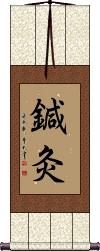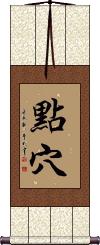Many custom options...
And formats...

Moxibustion in Chinese / Japanese...
Buy a Moxibustion calligraphy wall scroll here!
Personalize your custom “Moxibustion” project by clicking the button next to your favorite “Moxibustion” title below...
Acupuncture and Moxibustion
鍼灸 is the Chinese, Japanese Kanji, and old Korean Hanja word for acupuncture-moxibustion.
Pressure Points
點穴 means pressure points in Chinese and Japanese.
In martial arts, this term refers to hitting a pressure point or vulnerable body cavity. 點穴 is not the term “dim mak,” but it is often used in place of or with dim mak.
In medical terms, these are just pressure points, which can be places for acupuncture or the application of moxibustion.
See Also: Dim Mak
Not the results for moxibustion that you were looking for?
Below are some entries from our dictionary that may match your moxibustion search...
| Characters If shown, 2nd row is Simp. Chinese |
Pronunciation Romanization |
Simple Dictionary Definition |
壮 see styles |
sou / so そう |
(noun or adjectival noun) (1) vibrancy; strength; bravery; manliness; (noun or adjectival noun) (2) (esp. of men) one's prime (approx. age 30); (counter) (3) (also 草) counter for times of moxibustion; (personal name) Yūki |
艾 see styles |
yì yi4 i mogusa もぐさ |
More info & calligraphy: Yai(1) (See 灸) moxa (dried mugwort leaf used in moxibustion); (2) (See ヨモギ・1) Japanese mugwort (Artemisia princeps); (surname) Yomogi |
壷 see styles |
tsubosaki つぼさき |
(out-dated or obsolete kana usage) (1) jar; pot; vase; (2) dice cup; (3) depression (i.e. the basin of a waterfall); (4) (archaism) target (when aiming an arrow); (5) (kana only) (figurative) bull's-eye; (6) (kana only) key point (of a conversation, etc.); (7) (kana only) acupuncture point; moxibustion point; (8) (kana only) nodes on a fingerboard (of a shamisen, etc.); hu (ancient Chinese vessel shaped like a vase, usually used to store alcohol); (surname) Tsubosaki |
壺 壶 see styles |
hú hu2 hu tsubosaki つぼさき |
pot; classifier for bottled liquid (out-dated or obsolete kana usage) (1) jar; pot; vase; (2) dice cup; (3) depression (i.e. the basin of a waterfall); (4) (archaism) target (when aiming an arrow); (5) (kana only) (figurative) bull's-eye; (6) (kana only) key point (of a conversation, etc.); (7) (kana only) acupuncture point; moxibustion point; (8) (kana only) nodes on a fingerboard (of a shamisen, etc.); hu (ancient Chinese vessel shaped like a vase, usually used to store alcohol); (surname) Tsubosaki |
壼 壸 see styles |
kǔn kun3 k`un kun tsubo つぼ tsuho つほ tsufu つふ |
palace corridor; fig. women's quarters; women (irregular kanji usage) (1) jar; pot; vase; (2) dice cup; (3) depression (i.e. the basin of a waterfall); (4) (archaism) target (when aiming an arrow); (5) (kana only) (figurative) bull's-eye; (6) (kana only) key point (of a conversation, etc.); (7) (kana only) acupuncture point; moxibustion point; (8) (kana only) nodes on a fingerboard (of a shamisen, etc.); (irregular kanji usage) (out-dated or obsolete kana usage) (1) jar; pot; vase; (2) dice cup; (3) depression (i.e. the basin of a waterfall); (4) (archaism) target (when aiming an arrow); (5) (kana only) (figurative) bull's-eye; (6) (kana only) key point (of a conversation, etc.); (7) (kana only) acupuncture point; moxibustion point; (8) (kana only) nodes on a fingerboard (of a shamisen, etc.) |
灸 see styles |
jiǔ jiu3 chiu kyuu; yaito / kyu; yaito きゅう; やいと |
moxibustion (TCM) moxibustion; (personal name) Kyū |
ツボ see styles |
tsubo ツボ |
(1) jar; pot; vase; (2) dice cup; (3) depression (i.e. the basin of a waterfall); (4) (archaism) target (when aiming an arrow); (5) (kana only) (figurative) bull's-eye; (6) (kana only) key point (of a conversation, etc.); (7) (kana only) acupuncture point; moxibustion point; (8) (kana only) nodes on a fingerboard (of a shamisen, etc.) |
一穴 see styles |
ikketsu いっけつ |
(1) one hole; (2) toilet bowl (for both urination and defecation); (3) effective point for moxibustion; (4) (colloquialism) one-woman man |
灸法 see styles |
jiǔ fǎ jiu3 fa3 chiu fa |
moxibustion (TCM) |
灸点 see styles |
kyuuten / kyuten きゅうてん |
(1) moxibustion treatment point; (2) spot (marked with ink) on which moxa is burned; (3) burning moxa on the skin |
艾灸 see styles |
ài jiǔ ai4 jiu3 ai chiu |
moxibustion (TCM) |
針灸 针灸 see styles |
zhēn jiǔ zhen1 jiu3 chen chiu shinkyuu / shinkyu しんきゅう |
acupuncture and moxibustion; to give or have acupuncture and moxibustion acupuncture and moxibustion |
鍼灸 see styles |
shinkyuu / shinkyu しんきゅう |
acupuncture and moxibustion |
鍼艾 see styles |
zhēn ài zhen1 ai4 chen ai shingai |
acupuncture and moxibustion |
砭灸術 砭灸术 see styles |
biān jiǔ shù bian1 jiu3 shu4 pien chiu shu |
acupuncture and moxibustion (Chinese medicine) |
艾條灸 艾条灸 see styles |
ài tiáo jiǔ ai4 tiao2 jiu3 ai t`iao chiu ai tiao chiu |
stick moxibustion; poling (TCM) |
艾炷灸 see styles |
ài zhù jiǔ ai4 zhu4 jiu3 ai chu chiu |
cone moxibustion (TCM) |
鍼灸師 see styles |
shinkyuushi / shinkyushi しんきゅうし |
acupuncturist and practitioner of moxibustion |
鍼灸院 see styles |
shinkyuuin / shinkyuin しんきゅういん |
acupuncture and moxibustion clinic |
無病自灸 无病自灸 see styles |
wú bìng zì jiǔ wu2 bing4 zi4 jiu3 wu ping tzu chiu |
lit. to prescribe moxibustion for oneself when not ill; to cause oneself trouble with superfluous action |
艾條溫和灸 艾条温和灸 see styles |
ài tiáo wēn hé jiǔ ai4 tiao2 wen1 he2 jiu3 ai t`iao wen ho chiu ai tiao wen ho chiu |
gentle stick moxibustion (TCM) |
艾條雀啄灸 艾条雀啄灸 see styles |
ài tiáo què zhuó jiǔ ai4 tiao2 que4 zhuo2 jiu3 ai t`iao ch`üeh cho chiu ai tiao chüeh cho chiu |
"sparrow pecking" moxibustion technique (TCM) |
Variations: |
kyuushi / kyushi きゅうし |
moxibustion practitioner; moxibustionist |
Variations: |
sou / so そう |
(noun or adjectival noun) (1) vibrancy; strength; bravery; manliness; (noun or adjectival noun) (2) one's prime (around age 30; esp. of a man); (counter) (3) (also written as 草) counter for cones or sticks of moxa burned on the skin (in moxibustion) |
Variations: |
shinkyuu / shinkyu しんきゅう |
acupuncture and moxibustion |
Variations: |
okyuu / okyu おきゅう |
(1) (polite language) moxibustion; (2) (See お灸を据える・1) chastisement; scolding |
Variations: |
tsubo(p); tsubo(p); tsuho(ok); tsufu(ok) つぼ(P); ツボ(P); つほ(ok); つふ(ok) |
(1) pot; jar; vase; (2) dice cup; (3) (See 滝壺) depression; basin (e.g. of a waterfall); (4) (kana only) (See 思うつぼ・1) aim; what one wants; the mark; (5) (kana only) key point (of a conversation, etc.); essence; (6) (kana only) acupuncture point; moxibustion point; pressure point; (7) (kana only) (often ツボ) position on the fingerboard (of a shamisen, koto, etc.); (8) (archaism) target (when aiming an arrow) |
Variations: |
tsubo(p); tsubo(sk) つぼ(P); ツボ(sk) |
(1) pot; jar; vase; (2) dice cup; (3) (See 滝壺) depression; basin (e.g. of a waterfall); (4) (kana only) (See 思うつぼ・1) aim; what one wants; the mark; (5) (kana only) key point (of a conversation, etc.); essence; (6) (kana only) acupuncture point; moxibustion point; pressure point; (7) (kana only) (oft. written as ツボ) position on the fingerboard (of a shamisen, koto, etc.); (8) (archaism) target (when aiming an arrow) |
The following table may be helpful for those studying Chinese or Japanese...
| Title | Characters | Romaji (Romanized Japanese) | Various forms of Romanized Chinese | |
| Acupuncture and Moxibustion | 鍼灸 / 針灸 针灸 | shin kyuu / shinkyuu / shin kyu | zhēn jiǔ / zhen1 jiu3 / zhen jiu / zhenjiu | chen chiu / chenchiu |
| Pressure Points | 點穴 点穴 | tenketsu | diǎn xué / dian3 xue2 / dian xue / dianxue | tien hsüeh / tienhsüeh |
| In some entries above you will see that characters have different versions above and below a line. In these cases, the characters above the line are Traditional Chinese, while the ones below are Simplified Chinese. | ||||
Successful Chinese Character and Japanese Kanji calligraphy searches within the last few hours...





